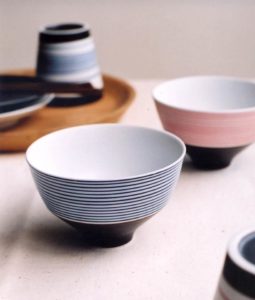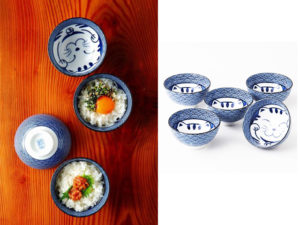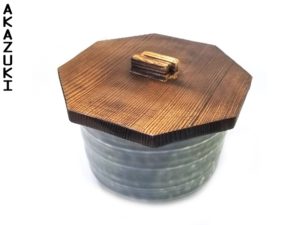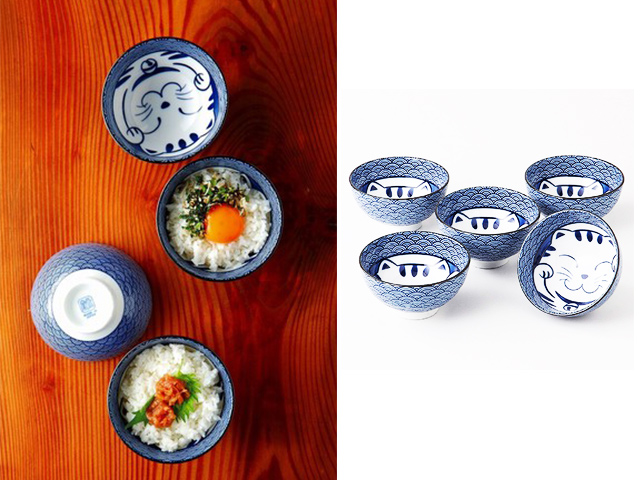An indispensable part of traditional cuisine
Japanese cuisine is a captivating symphony of flavors, colors, and textures, deeply rooted in the country’s history and cultural traditions. However, it is not only the food that plays a crucial role in this culinary orchestra but also the vessels in which it is served. Among them, Japanese bowls, with their varied shapes, sizes, and designs, hold a special place. This guide will walk you through the diverse world of Japanese bowls, their uses, and their cultural significance.
1. Rice bowls (Chawan)
 The chawan, a cylindrical rice bowl slightly smaller than a western soup bowl, is a staple in Japanese dining. Typically used for serving steamed rice, the backbone of almost every Japanese meal, the chawan comes in various sizes and designs, often made of ceramic or lacquerware.
The chawan, a cylindrical rice bowl slightly smaller than a western soup bowl, is a staple in Japanese dining. Typically used for serving steamed rice, the backbone of almost every Japanese meal, the chawan comes in various sizes and designs, often made of ceramic or lacquerware.
2. Soup bowls (Wan)
 Wan is a generic term for bowls in Japanese, but it’s often used to refer specifically to miso soup bowls. These bowls are typically made of lacquered wood and have lids to keep the soup warm. The lid also serves the purpose of enhancing the eating experience by letting the diner enjoy the aroma of the soup when lifted.
Wan is a generic term for bowls in Japanese, but it’s often used to refer specifically to miso soup bowls. These bowls are typically made of lacquered wood and have lids to keep the soup warm. The lid also serves the purpose of enhancing the eating experience by letting the diner enjoy the aroma of the soup when lifted.
3. Noodle bowls (Menbachi or Donburi)
 Menbachi, meaning “noodle bowl,” is larger and deeper than the standard rice bowl, designed to hold the hearty servings of ramen, udon, or soba noodles. On the other hand, Donburi bowls are used for dishes where various ingredients are served over a bed of rice, such as gyudon (beef bowl) or katsudon (pork cutlet bowl).
Menbachi, meaning “noodle bowl,” is larger and deeper than the standard rice bowl, designed to hold the hearty servings of ramen, udon, or soba noodles. On the other hand, Donburi bowls are used for dishes where various ingredients are served over a bed of rice, such as gyudon (beef bowl) or katsudon (pork cutlet bowl).
4. Tea bowls (Chawan)
 While the term ‘chawan’ is used for rice bowls, it also refers to the bowls used in the Japanese tea ceremony, known as ‘matcha chawan’. These matcha bowls are crafted with artistic precision and are often rustic and irregularly shaped, reflecting the wabi-sabi aesthetics of the tea ceremony.
While the term ‘chawan’ is used for rice bowls, it also refers to the bowls used in the Japanese tea ceremony, known as ‘matcha chawan’. These matcha bowls are crafted with artistic precision and are often rustic and irregularly shaped, reflecting the wabi-sabi aesthetics of the tea ceremony.
5. Serving bowls (Owan)
 Owan refers to larger bowls used for serving communal dishes or individual portions of larger dishes like stews or hot pots. They can be lidded, similar to miso soup bowls, and are commonly made of ceramic, glass, or lacquered wood.
Owan refers to larger bowls used for serving communal dishes or individual portions of larger dishes like stews or hot pots. They can be lidded, similar to miso soup bowls, and are commonly made of ceramic, glass, or lacquered wood.
6. Soba bowls (Soba Choko)
 Despite the name, soba choko is a versatile piece of tableware and can be used for more than just soba noodles. It is smaller and often used for side dishes or dipping sauces.
Despite the name, soba choko is a versatile piece of tableware and can be used for more than just soba noodles. It is smaller and often used for side dishes or dipping sauces.
The aesthetic and cultural significance of Japanese bowls
Beyond their functional role, Japanese bowls carry a deep aesthetic and cultural significance. They are carefully selected to complement the color, texture, and shape of the food, enhancing the overall dining experience. The choice of bowl is also influenced by the season, occasion, and the personal preference of the host.
Choosing the right bowl for your home
When selecting Japanese bowls for your home, consider both the functional aspects and the aesthetic appeal. Choose bowls that will serve the types of meals you prepare most often. For instance, if you love making ramen, a deep, wide Menbachi will be indispensable. If you regularly enjoy rice dishes, investing in beautifully crafted chawan would be a good choice.
Remember, the beauty of Japanese bowls lies not only in their individual charm but also in how they harmonize with the food and other tableware. So, consider the overall palette of your dishes and your dining decor when choosing your bowls.
Caring for your Japanese bowls
To maintain the beauty and longevity of your Japanese bowls, treat them with care. Many Japanese bowls, especially those made of lacquerware or hand-painted ceramics, should be hand-washed. Avoid using abrasive cleaners, and never use them in a microwave if they are made of metal or have metallic accents.
In conclusion
Japanese bowls are much more than functional kitchenware. They are an embodiment of the country’s aesthetic principles, cultural traditions, and the spirit of hospitality. By understanding the different types of Japanese bowls and their uses, you can bring the authenticity of Japanese dining experience into your home and develop a deeper appreciation for this extraordinary cuisine.
Whether you’re savoring the subtle flavors of matcha in a rustic chawan or tucking into a comforting bowl of ramen in a Menbachi, remember that these bowls are a testament to a culinary tradition that values harmony, balance, and the joy of shared meals. Indeed, the Japanese bowl is not just a vessel for food, but a vessel for delivering a rich, cultural experience.

Leave a Reply